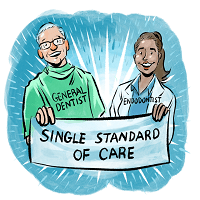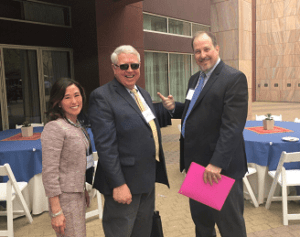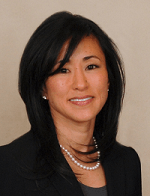AAE Promotes a Single Standard of Care at Dental Directors Meeting
By Elisabeth Lisican
On the heels of AAE18, a biennial meeting with dental directors from the major dental benefit plans took place in Scottsdale, Ariz., on May 1. This meeting is a key component of AAE stakeholder advocacy and outreach.
AAE leadership, including President Dr. Patrick E. Taylor, Immediate Past President Dr. Garry L. Myers and Executive Director Ken Widelka, attended the meeting, along with 2018-2019 Practice Affairs Committee Chair Dr. Elizabeth Shin Perry and AAE staff Kimberly FitzSimmons, Helen Jameson and Brenda Stewart.
 The AAE meets with the dental directors of insurers every other year to present an update on the current state of endodontics and to advocate for our members and patients on areas of concern related to insurers and endodontic coding.
The AAE meets with the dental directors of insurers every other year to present an update on the current state of endodontics and to advocate for our members and patients on areas of concern related to insurers and endodontic coding.
“As the representatives at this meeting are dentists, they understand our issues and we speak a common language,” Dr. Taylor said.
One major hope for this meeting was that this “common language” would help advance a single standard of care. Dr. Myers kicked off the discussion with a presentation on the topic.
“Is this realistic or is it a pipe dream that we could engage and work together to make sure we have one standard of endodontic care regardless of who is performing it?” he asked the group, as he opened his presentation.
Throughout his presentation, Dr. Myers reinforced the importance that all endodontic procedures be held to the standard of the endodontist, and that there should not be a lower standard for a procedure performed by a non-specialist.
Dr. Myers also presented to the dental directors both of the AAE’s recent white papers: Endodontic Competency and Treatment Standards, and the most recent position paper on Maxillary Sinusitis of Endodontic Origin.
The dental directors were especially interested in using the white papers as a measure for the standard for endodontic care by their providers. They agreed that the papers and related resources could be used as a way to hold their providers accountable to the AAE’s standard for endodontic care.
A dynamic conversation followed with large areas of philosophical agreement and a shared recognition that there are opportunities but no easy solutions.
“Both sides came away with a different appreciation of the opposing view,” Dr. Taylor said.
The dental directors agreed with the goal of one standard of care, noting that no one wants to condone or pay for substandard care. It was evident insurers see a lot of subpar endodontics being performed by general dentists. Several of the directors also noted the importance of an educated consumer in moving the dial and commended the AAE on its upcoming consumer engagement initiative. The group agreed that the pendulum had swung away from implants as a “permanent” fix because they do not last forever, and peri-implantitis is a reality.
“These presentations over the past couple of years, along with the consistent theme of quality of care, have resonated with this group and they have welcomed and embraced our input,” Dr. Myers said.
“It would be a very big step forward for our specialty if insurance companies could actually hold dentists accountable to the AAE’s standards for endodontic procedures performed,” wrote Dr. Perry in a post-meeting report.
As for the dental directors’ takeaways, one representative was quoted as saying:
“I wish to highlight the efforts by AAE to establish quality standards for endodontic therapy. Dental benefit plans are typically charged in their employer contracts to only benefit services that meet acceptable standards of care. As you can imagine, administering this covenant of the contract is, at best, a significant challenge or totally impossible when standards of care are either unclear or nonexistent—which tends to be the case for the vast majority of dental procedures.
“It is when the ‘art’ of dentistry outweighs the ‘science’ of dentistry. ‘Art’ is in the eye of the beholder. ‘Science’ is factual. I said it in our meeting and I will reiterate my kudos to the AAE for accepting the challenge of establishing minimum standards for care.”
The group was also enthusiastic about the proposed one-hour webinar on endodontic competency that the AAE will develop over the next year and offer free to general dentists via Endo on Demand.
“While our perspectives are similar in many respects, it is up to the AAE to continue to generate documents that establish the endodontic standard of care that these dental benefit companies can base their decisions on,” Dr. Myers said. “This is a group we need to and should continue to develop conversations with on this concept of dental benefit reimbursements for procedures meeting a certain level of care.”
Providing established standards on which dental benefit companies can base their reimbursements for endodontic treatments will most likely gain the attention of the general practitioners doing endodontics and hopefully open lines of communication on the general practitioner-endodontist referral patterns in the future.
“Dental benefit plans will be much more effective when they are reimbursing procedures that have the best outcomes and prognosis,” Dr. Myers said. “We, the AAE, need to keep up our efforts to not only establish the standard of care for endodontics, but to also provide data that shows the high levels of success of endodontic treatment when these procedures are done to meet the standard that is established by the AAE.”
Elisabeth Lisican is integrated communications specialist for the AAE. She can be reached at 800-872-3636 x3021 or elisican@aae.org.
Coding Update
By Dr. Elizabeth Shin Perry
During the Dental Directors Meeting, I reported on the endodontic codes that were proposed at the March ADA Code Maintenance Committee meeting by the National Association of Dental Plans. The codes proposed by the NADP were: 1) restoration of an endodontic access and 2) root canal therapy of a primary tooth without a succedaneous tooth. The AAE did not support the proposed codes at the CMC meeting and they did not pass. The dialogue regarding the proposed codes was interesting, and the AAE is advocating for our members to ensure that any additional codes or changes to our current codes are in alignment with providing the best possible care for our patients while protecting the interests of the members of AAE. This continued dialogue with the insurers gives us insight into making positive decisions in coding changes for our membership.
As endodontists, we all face similar issues in dealing with insurance companies and the submission of insurance claims. I had the opportunity to raise some of our more prevalent issues with the dental directors and initiate conversation with them regarding possible solutions. Included in the discussion was our dissatisfaction of the “disallowed” procedures. Some of the other concerns I presented were lack of reimbursement for post removal (D2955), removal of separated instruments (D3331-removal of obstruction), negotiating through significant calcifications, (D3331), and removal of Thermafil, all of which take significant time and expense by the endodontists but often are denied or disallowed procedures by insurers.
Overall, the discussion from the dental directors was positive and they were interested in partnering with the AAE to provide better care for their patients. When faced with an insurance challenge, it is important for our members to follow up with appeals and/or further discussion with a dental consultant (who is a dentist) of the insurer. All members should keep in mind that the AAE is a valuable resource in negotiating any such situation. By continuing a positive relationship with the dental directors of the insurers, we are hopeful that our influence can make a difference for the future our specialty.
Dr. Elizabeth Shin Perry, D.M.D., has been practicing endodontics in Westfield, Mass., since 1995. She is a Diplomate of the American Board of Endodontics and chair of the Practice Affairs Committee. Dr. Perry can be reached at drperry@perryendo.com.





